The Legendary Trilogy: Barrera vs Morales
Hey there, fellow boxing aficionados! If you’re anything like me, you revel in the stories behind the punches. There’s nothing quite like witnessing a rivalry that transcends mere competition to become a saga of determination, skill, and national pride. Today, we’re diving into one of the most iconic rivalries in boxing history: Marco Antonio Barrera versus Erik Morales. This wasn’t just about who was tougher in the ring—it was a narrative that unfolded over years, leaving an indelible mark on the sport and its fans.
I still remember watching those fights with my friends, each bout filled with nail-biting tension and explosive moments. It felt like more than just watching two athletes go head-to-head; it was an emotional roller coaster that kept us all on the edge of our seats. These two Mexican warriors gave everything they had in a trilogy that spanned four years, from 2000 to 2004. Let’s take a closer look at how these epic battles not only showcased their unmatched talents but also captured the hearts of fans worldwide.
Key Takeaways
- The trilogy consisted of three matches between 2000 and 2004, all held in Las Vegas.
- Each fight went the distance, highlighting both fighters’ endurance and skill.
- The rivalry was about more than just wins and losses; it was a battle for national pride and legacy.
The First Encounter
The first bout between Barrera and Morales took place at 122 pounds and was nothing short of electrifying. Imagine two gladiators entering an arena with neither willing to back down. That’s exactly what happened when these two stepped into the ring. The match ended in a decision win for Morales, but it was shrouded in controversy. Many fans and analysts debated the judges’ decision, believing Barrera might have deserved the victory. This debate fueled an immediate clamor for a rematch, setting the stage for an intense rivalry.
This fight wasn’t just another match; it was an event that captured everyone’s attention. The fierce exchanges and relentless aggression turned it into an instant classic. For Morales, winning this fight was more than just adding another victory to his record—it elevated his career prospects dramatically. At the same time, it left Barrera with a burning desire to even the score. The demand for a second showdown was palpable as both fighters left the ring with unfinished business.

The Rematch Strategy
Their second encounter saw both fighters step up to 126 pounds, and with this change came a shift in strategy. Barrera came into the fight with newfound determination and a strategic game plan. He focused on intelligent boxing rather than sheer aggression, showcasing his ability to adapt and outsmart his opponent. This time around, he communicated effectively with his corner, which allowed him to make crucial adjustments during the fight.
While the rematch lacked some of the raw brutality of their first encounter, it was no less thrilling for those who watched it unfold. Barrera’s tactical superiority won him a clean victory, leaving him relieved and vindicated after his previous loss. This bout further enriched the narrative of their rivalry, proving that both men were capable of evolving their styles to meet new challenges. For fans, it added another layer of intrigue as they eagerly anticipated what would happen next.

Once and For All: The Final Showdown
The third and final bout between Barrera and Morales was aptly named “Once and For All.” Fought at the 130-pound limit, this match promised—and delivered—a spectacular display of boxing prowess. From the opening bell, Barrera seemed determined to make his mark by controlling the pace and delivering powerful punches that visibly shook Morales. Yet true to form, Morales demonstrated incredible resilience by weathering the storm.
This last chapter in their trilogy reached its peak during rounds 11 and 12 when both fighters dug deep into their reserves of strength and skill. As spectators held their breath, every punch carried weight not only physically but emotionally as well. In those final moments, it was clear that this fight would be remembered as one of boxing’s classic confrontations. The judges’ scorecards revealed a narrow victory for Barrera—a fitting end to an epic saga that captivated audiences around the globe.
Final Thoughts
As we look back on these legendary matchups between Barrera and Morales, it’s impossible not to appreciate what they brought to boxing history—courage, skill, determination—and most importantly—a captivating story that continues to inspire boxers today. This trilogy wasn’t merely about championship belts or individual accolades; it represented something much larger—a testament to human spirit under pressure.
Even now as we celebrate over two decades since their last meeting inside those ropes echoing cheers of “Viva Mexico,” we find ourselves reflecting upon lessons learned from such intense battles: perseverance amidst adversity; respect among rivals despite fierce competition; triumph beyond mere victories recorded within official records books themselves…and ultimately passing torches onto newer generations igniting same passions once kindled by these legends themselves!
Barrera vs Morales
boxing rivalry
Mexican boxing legends
iconic sports moments


Leave a Reply